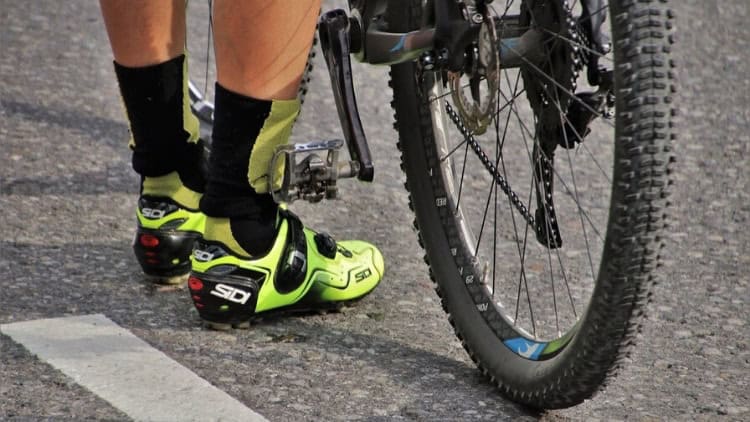Mountain Biking has had a lot of really cool innovations in recent years.
And these recent trends have been catching on remarkably fast.
In fact, we have reached a point where Dropper Posts have almost become an essential component for any serious Mountain Bike.
Among these recent developments in Mountain Biking, some of the most major changes have been in the wheel sizes.
One of the most popular, and possibly most controversial, is the 27.5.
Often boasted as the best of both worlds, even referred to as the “Goldilocks” of wheel sizes, the 27.5 has been gaining traction in the industry, and even more fans among riders.
But are they really that much better or worse than the current bike you have?
And are they worth the investment to see what they’re all about?
In this article, we break down the Pros and Cons of 27.5-inch Bikes, along with a few common questions and answers to help you make the best decision on your own.
Pros
- 1. Balanced Size for Most Riders
- 2. Increased Rolling Inertia
- 3. Almost as Strong as 26-inch Wheels
- 4. Better Acceleration than 29er
- 5. Better Traction than 26er
- 6. Lighter than 29er
Cons
- 1. Relatively Expensive
- 2. Parts not as Widely Available
- 3. Slower Acceleration than 26er
- 4. Less Traction than 29er
- 5. Less Maneuverable than 26er
- 6. Heavier than 26er
For a quick breakdown of the pros and cons of 27.5 bikes, here is an at-a-glance look at some of the points we break down in this article. If you’re interested in how 27.5 bikes stack up against other Mountain Bikes sizes, check out these articles on the other popular wheel sizes available; Pros and Cons of 29ers.
Pros

1. Balanced Size for Most Riders
Coming somewhere in between 26ers and 29ers, the 27.5 is the perfect size Mountain Bike for just about any rider.
Of course, larger or smaller riders may prefer either of the two extremes, but the 27.5 is a solid middle ground.
And it doesn’t just come down to wheel size, it also has to do with the frame geometry and how the rider is positioned on the bike.
You will find that the 27.5 allows for quite a bit of movement, without feeling too small beneath the rider.
2. Increased Rolling Inertia
Since 27.5-inch wheels are bigger than 26ers, they are also a little heavier.
While this weight gain is minimal, you will most likely feel the benefits straight away if you’re coming from a 26er.
With the increased rolling mass and the law of inertia on your side, you may find it a little easier to maintain speed on your Mountain Bike.
This also comes in handy when you’re bouncing over rocks, roots, and technical trails.
The added weight will help your bike stay straight as opposed to bouncing around the trail, losing your forward energy.
3. Almost as Strong as 26-inch Wheels
With a slightly larger diameter than 26ers, the 27.5 is still comparable in strength.
The spokes are marginally longer, and the tire is still close enough to the Hub to give you that strength and stability.
Even in areas like DH, where 26ers have long reigned, we are starting to see more and more 27.5-inch bikes on the trail.
4. Better Acceleration than 29er
If you’re needing something for those longer rides, but don’t want to miss out on that quick acceleration, a 27.5 may be the right bike for you.
Again, straddling the line between 26ers and 29ers, the 27.5 is a perfect middle ground when it comes to acceleration.
Limited mass and material allow for quicker starts and more responsive inputs.
Not only are you dealing with a lighter wheel than a 29er, the 27.5 is more comparable to the 26er when it comes to finding a middle ground.
5. Better Traction than 26er
With the larger wheel sizes, there are few things that begin to play to your benefit.
One of the lesser pronounced benefits is the additional surface area you occupy, as your tire now has more contact with the ground.
While this can definitely translate to more rolling resistance, it also gives you a slight increase in traction of the 26-inch wheel.
If you’re coming from a 26er, you may not even notice a change in traction, and if you’re looking for more traction, you will be better off with an upgraded tire.
However, this is still an advantage to 27.5-inch bikes.
6. Lighter than 29er
Finally, it is worth pointing out how much lighter 27.5-inch bikes are compared to the similarly popular 29er.
Again, with the 27.5 taking more after the 26er, the wheels will be a huge weight savings, especially if you’re looking for a full suspension.
On top of this, manufacturers are able to design bikes with a frame geometry that better suits smaller and lighter bikes.
Cons

1. Relatively Expensive
I have to admit, the 27.5 is a really innovative addition to the world of Mountain Biking, and I will gladly pay for the years of R&D manufacturers have put in, but I am also aware of the novelty that comes with this relatively new trend.
While I am sure we are paying for the additional material when we choose a 27.5 over a 26er, I still feel like the novelty of the 27.5 will keep prices on the higher side.
On top of this, the market is still catching up to 27.5 compared to the widely available 26er, so it will be harder to source parts and upgrades without paying a premium.
Even though budget bikes have caught on to the trend, you will be less likely to find spare tubes and parts at your local department store like how you would with a 26er.
2. Parts are Not as Widely Available as 26ers
Unfortunately, not all Mountain Bike components are interchangeable amongst the different wheel sizes.
When it comes time to upgrade or replace a component on your 27.5, you may have trouble sourcing the right parts, especially if you’re hoping to find something used.
And with the current market trend more in favor of Supply, manufacturers are less likely to mark down prices for a while.
3. Slower Acceleration than 26er
This next one is a bit controversial considering how close the 27.5 is to the 26er, however, it is easy to see why it is hypothesized.
With how much slower accelerating the 29er is compared to the 26er, you would expect the 27.5 to suffer from a fractional decrease in acceleration as well – seeing that it is also a larger diameter and therefore heavier wheel, however, some argue that the percentage is so small, it should hardly be mentioned.
Regardless, you can expect to have to use a little more energy to get and stay where you’re going if you’re used to the 26-inch wheel.
4. Less Traction than 29er
While the 27.5 easily has more traction than a 26er, it is no comparison to the traction seen with a 29er.
Again, the difference may not even be that noticeable to some, but it is definitely one of the disadvantages
5. Less Maneuverable than 26er
Just like the 29er, when you add more weight to a set of wheels, they will be a lot harder to throw around.
While this translates more into responsiveness, it also plays a role in how the rider fits on the bike.
Naturally, the 27.5 will be a larger feeling bike than the 26er.
This comes down to, not only the wheels but also to the way the frame geometry is built around those wheels.
The bottom bracket will still be in a more aggressive position, and the bike will require a little more energy to effort to move around.
6. Heavier than 26er
Finally, the 27.5 will often be a little heavier than its 26-inch counterpart.
While this minor increase may not matter to most of the average riders out there, this plays a key role for any professional or amateur athlete.

Are 27.5-inch Wheels Better than 26?
Coming in almost completely in the middle of 26ers and 29ers, the 27.5 is often thought of as the perfect balance between the two.
Some people have even speculated that the 27.5 will eventually drive the old 26er extinct.
While this can be easy to see at first, there are a lot of indications that our beloved 26ers are here to stay.
Still, you may be wondering if the 27.5-inch wheel is better than the 26.
Although they are very well balanced, the 27.5-inch wheel is too close to the 26er to really outshine it completely.
And while it is slightly better at maintaining speed and rolling over obstacles, it is not as strong or widely available as the 26-inch wheel.
What it really comes down to is deciding if a 27.5-inch bike is better for you.
What are 27.5-inch Bikes Good for?
Although the 27.5 takes more after the 26er than the 29er, it is hard to argue with how well-balanced they are as a Mountain Bike in general.
Added stability and speed without sacrificing maneuverability makes for a really capable machine.
With this, I have to say that the 27.5 is good for just about any discipline of Mountain Biking, from Downhill to XC.
Who Should Buy a 27.5-inch Bike?
Again, the 27.5-inch bike is one of the most well-rounded Mountain Bike sizes available, and chances are, it will be a solid fit for you.
But to better make that decision, you really have to think about your riding preference, budget, and dedication to the sport.
If you want to be at the forefront of the latest wave of Mountain Bikes, buy yourself a 27.5 and join the club.
If you’re looking for a step up from your 26er but feel like the 29er is too big, it is worth trying out a 27.5.
Regardless, they are a solid investment for most riders.
Should I get a 29er or a 27.5?
If you’re looking to upgrade from your 26er to larger tire size, you may be stuck between the 29er and the 27.5.
While both should be a decent upgrade from the bike you have now, you may be better suited for one over the other.
To better make the decision between the two, it really comes down to your budget, personal preference, and most importantly, fit.
If you like the smaller frame geometry of the 26er, you may want to stick with the 27.5.
If you feel like the 26 is way too small, finding a 29er in your size should be a breeze.
At the same time, make sure you try to head to your LBS for a fitting before making a decision.
Conclusion
In conclusion, the 27.5 has a list of advantages and disadvantages that make it a great choice for someone stuck between a 26er and a 29er.
While they are still relatively new to the market, they are definitely one of the most well-rounded Mountain Bikes you can buy.
Good luck making the right decision and safe riding!

